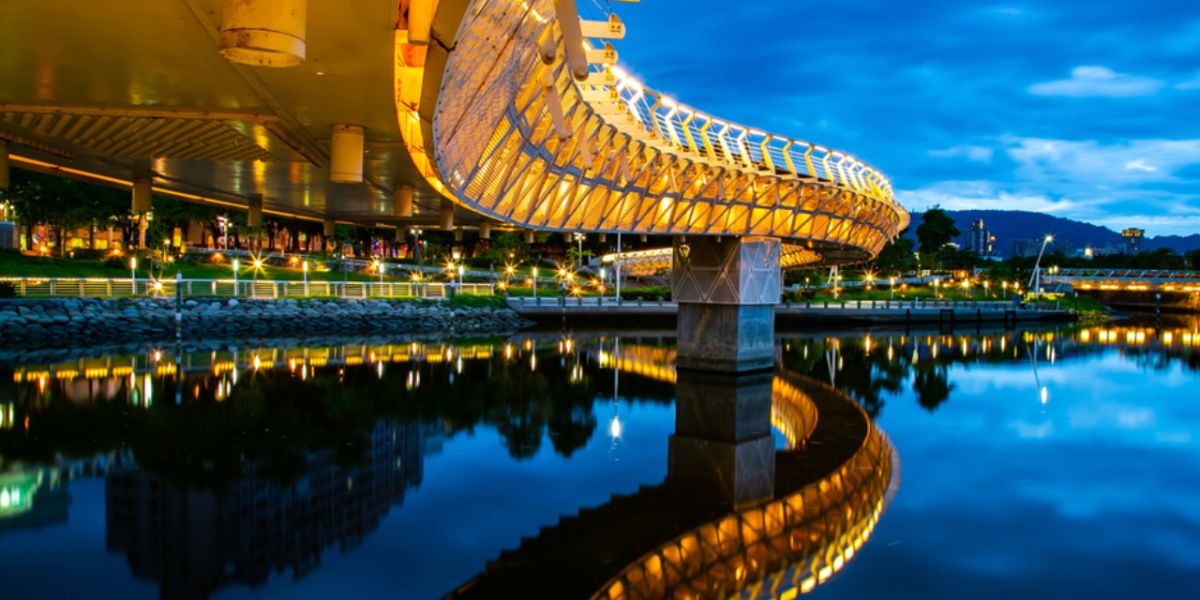
Taiwan has a lot to offer to travelers as well as expats when it comes to leisure. There are activities throughout the year and for all types of weather conditions.
Festivals in Taiwan
Major events in Taiwan include New Year's Eve fireworks at Taipei 101, the Taiwan Lantern Festival (which rotates the location each year), the Pingxi Sky Lantern Festival, the Fulong Sand Sculpting Art Festival, the Dragon Boat Festival, and many temple celebrations that involve a lot of firecrackers.
The national holidays in Taiwan include the Chinese Lunar New Year, a weeklong holiday during which many people return to their hometowns or travel abroad. The cities are usually quiet, and businesses close during the holiday. The end of the Lunar New Year is marketed by Lantern Festival, during which cities have light displays for the public to enjoy. Mid-Autumn Festival is a shorter holiday during which many people take the opportunity to travel in or out of Taiwan. In the spring, you can watch dragon boat races to celebrate Qing Ming (Tomb Sweeping Day).
During holidays, the most popular tourist destinations around Taiwan can get incredibly crowded. In some cases, train tickets sell out, and hotels are fully booked. If you plan to travel during the holidays, plan well in advance.
Concerts and theater in Taiwan
There are concerts and theater performances everywhere in Taiwan. The largest venues are the National Concert Hall and Theater in Taipei, the National Taichung Theater, and The National Kaohsiung Center for the Arts, which is set to open soon.
Tickets for performances can be purchased online through various services such as ibon, Arts Tickets, and kktix. The majority of the information and ordering processes will be in Chinese.
For the younger expats and visitors in Taiwan, there's Spring Scream in Kenting, held every year during spring break. The multiple-day concert is full of students and younger expats who travel to the southern tip of Taiwan for a huge party.
Things to do in Taiwan outside the cities
Traveling around Taiwan is fairly easy. However, the island's interior can be more difficult as most trains only travel around the coast. You will need to catch a bus or rent a car for trips to the mountains.
The most popular destinations for nature lovers in Taiwan include Taroko Gorge and Alishan. Both of these top destinations require some planning if you want to experience them during the weekend. It is advised to have at least three days for each due to the travel time to reach each.
There is plenty more hiking around Taiwan, including multiple trails in Taipei. For expats in Taipei, Yangmingshan is an easy day trip, with various opportunities to see different parts of the National Park. Taiwan offers hiking trails for novices as well as more experienced hikers. Some hikes now require government approval before attempting. There are a few hiking groups on Meetup.com that are highly recommended.
If hiking isn't your thing, there's a lot of biking as well. Taipei has miles of riverside parks to keep city dwellers busy. And there are tours that offer bike rides around the island, usually 10 days to ride the coastal loop.
Museums in Taiwan
Taiwan is home to many museums and cultural centers worth visiting.
In Taipei, the capital, the highlight is most definitely the National Palace Museum. Home to a trove of historical and artistic treasures, many of which were brought to Taiwan but the retreating Nationalist (KMT) forces as they fled following the loss of the Chinese Civil War in 1949, the museum has items spanning some 8,000 years of Chinese history, with a permanent collection encompassing some 700,000 pieces that are presented to the public on a rotating basis.
For education on Taiwan's multifaceted, multicultural, and multilingual Indigenous cultures, a visit to the Shung Ye Museum of Formosan Aborigines is also a must. Located in the Shilin District of Taipei, the museum is home to artifacts and exhibits detailing the depth and breadth of the 16 officially recognized Indigenous tribes of Taiwan—the first people to inhabit the country and present here for thousands of years prior to Taiwan being inhabited by Han Chinese and other settlers.
One more museum to visit in the capital is its oldest, National Taiwan Museum. The museum was established over a century ago when Taiwan was under the control of the Japanese. Inside, visitors can peruse exhibits on Taiwan's natural history, its Indigenous peoples, and its native flora and fauna.
For the literati crowd, there is the National Museum of Taiwan Literature in the southern city of Tainan. There, visitors are taken on a tour of the written word in Taiwan in the halls of a historic building that was erected in 1916 during the Japanese Colonial Era. The museum houses works written in Mandarin Chinese, Classical Chinese, Taiwanese, and Japanese, with English-language explanations and audio tours available for most exhibits.
Adventure sports in Taiwan
There are many options when it comes to adventure sports in Taiwan, with the majority of the country, aside from the western floodplains, where most of the population resides, covered by mountains and forests.
River tracing
In the Central and Coastal Mountain Ranges, in addition to hiking, river tracing is popular among local and foreign tourists as well. There are many groups taking tourists on guided treks through mountain streams. Keep in mind that while enjoyable, river tracing is a dangerous activity and requires safety equipment such as helmets, proper water shoes, and life jackets. Avoid any companies that may operate without such equipment or seem lax in their enforcement of its use.
Hualien is the most popular destination for river tracing, just a short train ride from the capital Taipei, where outfitters take groups along and through the Shakadang and Sanzhan rivers.
Kayaking on the ocean
On Taiwan's eastern coast, there are certain destinations popular with kayakers, where the currents are safe and the seas of the blue Pacific relatively calm. As is the case with river tracing, Hualien is again the destination of choice. There, the Qingshiu Cliffs, towering coastal walls of rock, provide a stunning backdrop for sunrise and sunset kayak tours.
River rafting
Hualien, again, is the star attraction when it comes to river rafting in Taiwan. Many outfitters operate on the Xiuguluan River, taking tour groups through sections of white water along the river's path through the mountains. Helmets and life jackets are provided, and instruction is given on the banks before the rafts depart. Spotters follow in motorized watercraft and assist any who may tumble out of the rafts. Guides are certified in CPR and lifeguarding.
Standup paddleboarding
In Yilan, also on Taiwan's east coast, closer to Taipei than neighboring Hualien further south, there are calm water coves suitable for standup paddleboarding. One of the most popular destinations for SUP in Yilan is Pirate's Bay, so named as once upon a time, it was known as a place for sea pirates to hide out. This is also the picturesque sight of Glass Beach, where the sea has worn the stones along the shore round and smooth, like beads of glass.
Paragliding
Locations in the mountains of the central county of Nantou and the east coast county of Hualien, where warm currents of air rise up the mountain slopes, are suitable for the sport of paragliding. There, instructors take tourists on tandem flights, launching from the mountainside, soaring down to landing points downslope or on the coastal alluvial plains, depending on the location.
Beaches in Taiwan
The most popular beaches in Taiwan are way down south in Kenting, on the Hengchun Peninsula, the southernmost point in the country. There you will find Baishawan, or White Sand Beach, which can be quite crowded during the peak tourist season in the summer but is relatively uncrowded by locals during the “cool” winter season. Getting to Kenting involves taking a regular train or the High-Speed Railway to Kaohsiung and then taking a bus to Hengchun. There are countless hotels, resorts, Airbnbs, and homestays to choose from in the area, and at night, Hengchung Night Market is a hive of activity, with hundreds of roadside stalls selling all manner of street food, souvenirs, and running carnival-style games.
Another easier option is Kaohshiung's Cijin Island, a short distance from the southern city of Kaohsiung proper by ferry in the Kaohsiung Harbor. The island has a popular beach as well, lined with eateries and indoor/outdoor clubs.
Camping/Glamping in Taiwan
Camping is becoming increasingly common in Taiwan as it strives to market itself as more of a place for outdoor activities, both domestically and abroad. Throughout the country, there are serviced campgrounds available for outdoor enthusiasts to enjoy camping with tents or with recreational vehicles.
In the north, near Fulong Beach and the banks of the Shuangxi River, is Longmen Camping site, with grassland and woodland sites for tents and RVs. Food and other supplies are also available there for purchase.
In Central Taiwan, CMP Village offers glamping opportunities, with on-site yurts featuring air conditioning and heating, depending on the weather conditions, and carpeted floors, beds, and other upscale amenities. The campground also has classes and D.I.Y. activities available for guests. And in the south, there is Shady Tree Campground in Kenting National Park. There are elevated platforms for tents, rustic cabins for rent, and hot-water showers. The campground's central location makes it an ideal spot to spend some time in the great outdoors while being relatively close to all of the national park's main natural attractions.
Hot springs in Taiwan
Hot spring culture first came to the foray in Taiwan when it was under the command and control of the Japanese from 1895 to 1945. During that period, hot spring resorts began to pop up in what is today known as Beitou District in Taipei, in the aptly named Geothermal Valley.
Today, some of those historic resorts dating back to the colonial era are still standing in one form or another. One of the most popular is the Beitou Public Hotspring—an outdoor spring that can be entered using an Easy Card (the same card used for the metro system and public buses). Entry costs just NT$40 per person, and lockers are available for rent for just NT$20. The public spring is open daily and only closes in cases of extreme inclement weather, such as typhoons. Pools are available at different temperatures, depending on one's preference/tolerance level, and there is a “cold pool” to cool down in if the heat ever becomes too much.
There are also countless “wild” hot springs in Taiwan—springs located in places that are unregulated, mostly known only to locals and foreign residents in the know. Some are easier to find and get to than others, and as it goes, those that are easier to get to are more crowded on weekends and holidays as Taiwanese and tourists alike alight for the great outdoors. These wild springs are located next to, or even within, stretches of Taiwan's many rivers. One such is Lulu Hot Spring, a stretch of over 1.5 kilometers of hot springs in Taitung on the Xinwulu River. These springs are accessible for beginners via river trace in Taitung's Haiduan Township.
Surfing in Taiwan
One of the fastest-growing outdoor/water sports in Taiwan is surfing, and there are many places around the main island where there are waves of varying gradients to catch.
In the north, surfing is possible at Fulong Beach, a 40-minute train ride from Taipei, but the waves are quite small and short-lived during the break. A better option for beginners and intermediate surfers is Wai'ao in Yilan County. There, the waves are slightly bigger than those at Fulong, and those who have never surfed before or perhaps require a refresher course can take a lesson provided by the beach's collection of surf schools. Alternatively, one can simply rent a board and give it a go.
For the more advanced, the village of Dulan in Taitung offers larger waves and less-populated breaks. Checking in at a surf hostel/school such as Wagilogong in the village is a good way to get the lay of the land (or sea, in this case) from those who live in the area and surf the waters daily. Windsurfing is also popular in the Dulan area.
We do our best to provide accurate and up to date information. However, if you have noticed any inaccuracies in this article, please let us know in the comments section below.








